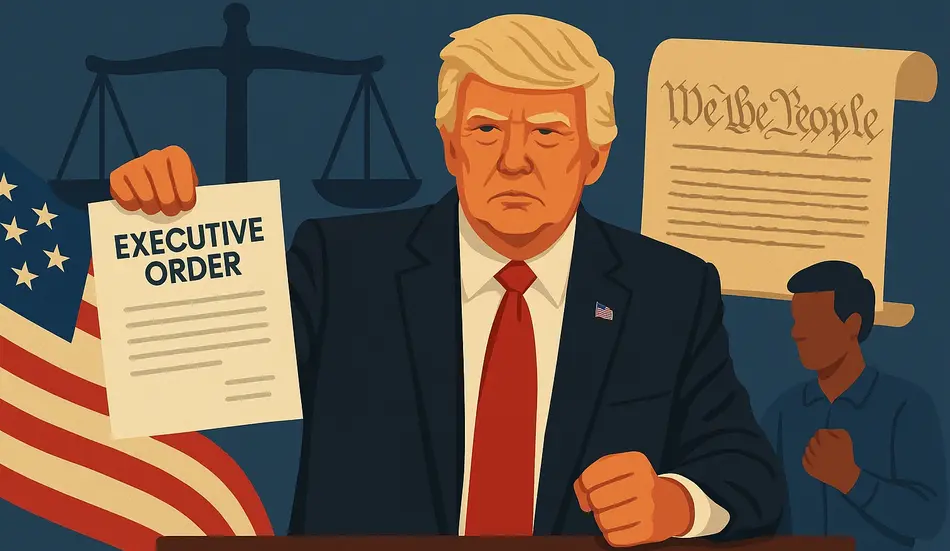The Hidden Constitutional Crisis: Presidential Overreach Through Executive Orders
A concerning pattern is emerging in the current administration – an unprecedented reliance on executive orders that threatens the fundamental constitutional balance of power in America. With over 35 times as many executive orders as new laws passed, we’re witnessing what many experts describe as an alarming power grab that bypasses traditional legislative processes and challenges the very foundation of American democracy.
The Staggering Numbers Reveal a Constitutional Crisis
The data paints a disturbing picture of executive overreach. While previous administrations maintained some balance between executive actions and legislative accomplishments, the current administration has “blown all precedent out of the water” with an executive order rate that dwarfs any previous president’s use of this power.
During the first 100 days alone:
- Current administration: Unprecedented number of executive orders
- Previous administration: Significantly fewer orders, more aligned with historical norms
- Obama administration: Roughly triple the ratio of orders to laws passed
- FDR administration: Maintained approximately 90 orders to 80 laws during the pivotal New Deal era
This isn’t merely a statistical anomaly—it represents a fundamental shift in how presidential power is being wielded, with profound implications for American governance.
The Constitutional Framework Under Siege
Article II and the Limits of Presidential Power
The Constitution carefully distributes power across three branches of government, with Article II specifically outlining—and limiting—presidential authority. Despite the former president’s claim that “I have an Article II where I have the right to do whatever I want as president,” constitutional scholars universally reject this interpretation.
As one expert in the transcript notes: “No one part can be more powerful than any other. Each controls the other… that’s what we call checks and balances.” This principle ensures that no single politician can accumulate excessive power—a foundational concept in American governance.
The current flood of executive orders appears designed to test these constitutional boundaries, pushing courts to grant powers that presidents traditionally haven’t possessed. This represents a direct challenge to the separation of powers doctrine that has safeguarded American democracy for over two centuries.
The Judicial Pushback
The courts have become the last line of defense against executive overreach, with many of these hastily drafted orders facing legal challenges:
- Multiple orders have been frozen by national injunctions
- Legal experts describe many as “lawsuit bait”
- Constitutional scholars warn about precedent-setting dangers
- Federal judges across the political spectrum have expressed concern
One recent example involves an attempt to redefine birthright citizenship through executive order—something constitutional scholars universally agree requires a constitutional amendment, not a presidential decree.
The Partisan Shift in Congressional Oversight
From Maverick Resistance to Compliant Support
The legislative branch’s role as a check on executive power has significantly weakened. During the previous term, figures like the late Senator John McCain famously provided crucial opposition to presidential overreach, as demonstrated by his decisive “thumbs down” vote that preserved healthcare protections for millions.
Today’s congressional leadership presents a stark contrast:
- Party leaders now consistently align with White House priorities
- Legislative independence has diminished dramatically
- Congressional oversight functions have been largely abandoned
- Lawmakers prioritize loyalty over constitutional duties
This shift has created a dangerous power vacuum where traditional congressional authority is increasingly ceded to the executive branch.
The Broader Strategy: Transforming American Governance
Beyond Individual Policies: A Systematic Power Shift
While daily news coverage naturally focuses on the content of specific executive orders—whether they target campus speech, diversity programs, or immigration policy—the cumulative effect reveals a more concerning pattern: a systematic effort to concentrate power in the White House.
This strategy includes:
- Bypassing expert review: Orders are frequently issued without consultation from relevant experts, even within the administration
- Flooding the courts: Overwhelming the judicial system with controversial orders forces courts to address multiple constitutional challenges simultaneously
- Testing boundaries: Each order that survives judicial scrutiny establishes new precedents for expanded executive authority
- Marginalizing Congress: By governing through executive action, the legislative branch becomes increasingly irrelevant
As one observer noted, the goal appears to be giving “the president authority over every part of the federal government”—a fundamental restructuring of American governance.
Public Response and Democratic Resistance
The Growing Backlash Against Executive Overreach
The American public has not remained passive in the face of these challenges to constitutional governance. Recent protests have drawn millions of participants concerned about the erosion of democratic norms and the concentration of power in the executive branch.
These demonstrations reflect a growing recognition that current events transcend traditional partisan divides and touch on fundamental questions about American governance:
- How much power should any president wield?
- What role should Congress play in major policy decisions?
- How can courts maintain independence while facing political pressure?
- What recourse do citizens have when constitutional norms are violated?
As one protester articulated: “The American people bow to no king.” This sentiment echoes the revolutionary principles that established our constitutional republic—a system explicitly designed to prevent the concentration of power in any single individual.
Historical Context: The Revolutionary Rejection of Monarchical Power
America’s Founding Principle: No Kings
The American Revolution was fundamentally a rejection of monarchical rule—a system where a single person could govern by decree without meaningful checks on their authority. The constitutional system that emerged was deliberately designed to distribute power across multiple branches and levels of government.
As the transcript eloquently states: “If the US was just going to have one leader doing whatever he wants with no checks, we would not have needed a revolution to reject that kind of rule by kings. Americans literally fought a war for the freedom to empower people, to oversee an accountable, temporary rotation of governments, rather than a single person being a king.”
This historical context provides crucial perspective on current events. The unprecedented concentration of power through executive orders doesn’t just challenge contemporary political norms—it threatens the foundational principles that inspired American independence.
The Long-Term Implications for American Democracy
Beyond the Current Administration: Precedent and Power
The danger extends beyond any single administration’s policies. Each successful expansion of executive power establishes precedents that future presidents—of any political persuasion—might exploit. This represents a structural shift in American governance that could permanently alter the constitutional balance of power.
Constitutional scholars warn about several concerning possibilities:
- Normalization of governance by decree: As executive orders replace legislation as the primary vehicle for policy implementation, Congress becomes increasingly irrelevant
- Judicial deference to executive authority: Courts may gradually accept expanded presidential powers as established precedent
- Erosion of democratic accountability: When major policies are implemented without legislative involvement, voters lose their most direct mechanism for influencing government
- Institutional damage: The weakening of constitutional checks and balances threatens the long-term stability of American democracy
These concerns transcend partisan politics—they touch on the fundamental structure of American governance and the distribution of power in a constitutional republic.
Protecting Constitutional Governance: The Path Forward
Restoring Checks and Balances
Preserving America’s constitutional system requires renewed commitment to the principles of separated powers and democratic accountability. Several crucial steps could help restore proper balance:
- Judicial independence: Courts must continue evaluating executive actions based on constitutional principles rather than political pressure
- Congressional reassertion: Legislators must reclaim their constitutional role in policymaking and oversight
- Civic education: Americans need greater understanding of constitutional principles and the dangers of concentrated power
- Bipartisan defense of norms: Leaders from across the political spectrum must prioritize constitutional governance over short-term partisan advantage
- Media vigilance: Journalists must highlight systemic threats to democratic institutions, not just daily policy disputes
The American experiment in self-governance has weathered numerous challenges throughout its history. The current crisis of executive overreach represents another critical test of the constitutional system’s resilience.
Conclusion: Democracy’s Defining Moment
The unprecedented flood of executive orders represents more than just a policy agenda—it reflects a fundamental challenge to America’s constitutional order. By governing primarily through White House decrees rather than legislation, the current administration threatens the separation of powers that has defined American democracy for over two centuries.
As citizens, scholars, judges, and legislators respond to this challenge, they participate in a struggle that echoes America’s founding principles: that power must be constrained, that no individual stands above the law, and that government derives its legitimacy from the consent of the governed.
The outcome of this constitutional confrontation will shape American governance for generations to come. At stake is not just which policies will be implemented, but how decisions will be made—whether through democratic processes that involve multiple branches of government, or through the unilateral actions of a single office.
In the words of Schoolhouse Rock, as quoted in the transcript: “No one part can be more powerful than any other. Each controls the other… that’s what we call checks and balances.” This principle remains as vital today as it was when the Constitution was written—a timeless safeguard against the concentration of power that threatens liberty itself.
Hiring?
Post Jobs for Constitutional Law Experts on WhatJobs.
Find qualified legal professionals with deep knowledge of constitutional frameworks and the limits of executive authority. Connect with candidates ready to support governance, policy, and legal compliance.
Post a Legal Job NowFAQ: Executive Power and Constitutional Balance
What makes the current use of executive orders different from previous administrations?
The current administration has issued executive orders at an unprecedented rate—over 35 times as many orders as new laws passed. This dramatically exceeds all historical precedents, including administrations like FDR’s that were known for active executive action. Previous presidents generally maintained some balance between executive orders and legislative accomplishments, working with Congress even when controlled by their own party. The current approach represents a fundamental shift toward governance by decree rather than through the traditional legislative process.
How does executive overreach threaten the constitutional separation of powers?
Executive overreach threatens the constitutional separation of powers by concentrating authority in the presidency at the expense of Congress and the courts. When presidents govern primarily through executive orders rather than legislation, they bypass the deliberative democratic process designed by the Constitution. This undermines Congress’s role as the primary lawmaking body and transforms the presidency into something closer to what the Founders explicitly rejected—a monarchy where one person can impose policies without meaningful checks or balances from other branches of government.
What role do courts play in limiting executive power through executive orders?
Courts serve as the critical final check against executive overreach by evaluating whether executive orders exceed constitutional boundaries. Federal judges can issue injunctions that temporarily block orders, and ultimately rule on their constitutionality. Recently, courts have frozen multiple controversial executive orders, including attempts to redefine birthright citizenship and other constitutional principles through executive action. This judicial review function becomes increasingly important when Congress fails to exercise its oversight responsibilities or when executive orders attempt to circumvent established legislative processes.
How can citizens help preserve constitutional checks and balances against executive overreach?
Citizens can help preserve constitutional checks and balances by staying informed about executive actions, supporting organizations that challenge unconstitutional power grabs through litigation, contacting their congressional representatives to demand proper oversight, voting for candidates who demonstrate respect for constitutional limits, participating in peaceful protests against executive overreach, and educating themselves about constitutional principles. Public awareness and civic engagement are crucial, as democratic institutions ultimately depend on citizens who understand and defend the constitutional separation of powers that prevents any single branch from accumulating excessive authority.




